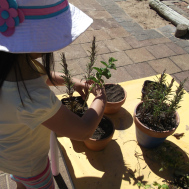
What is looping?
Looping is where we have groups of children and educators that stay together, transitioning through from Baby House, Toddler House, May Mills House and where possible Preschool House. Looping allows children, educators and families time to come to know each other extremely well and makes the process of transitioning smoother for those involved. We recognise the importance of secure, consistent relationships for very young children. For this reason, Flinders University Child Care Centre practises ‘looping’.

Put simply, looping keeps groups of people together for the first three years of a child’s life, so that whilst the setting may change (Baby House to Toddler House, Toddler House to May Mills House) the people, and most importantly the relationships, remain the same. Children and educators from Baby House go to Toddler House, then to May Mills House, then educators go back to Baby House to begin the looping process again. Not all of the educators move to the next house; a few either stay in the house they are currently in or move to another house altogether.
Why is looping important?

Contemporary research shows the significance of consistent relationships for children in the first three years of life. In early childhood environments, this consistency is often achievable due to traditional developmental systems, which move children into the next building as soon as they reach a certain age or developmental milestone.
In the traditional system, a child who begins attending Flinders in Baby House would typically undergo three or four transitions by the time they are three. This means building relationships, establishing trust, and developing confidence three or four times. Whilst many children and families manage this well, and whilst our educators are extremely skilled at supporting children and families through this process, it remains a stressful time. Maintaining the majority of the educator team as the children transition eliminates one of the ‘unknowns’ for children and families as the move across the path or up the hill.
